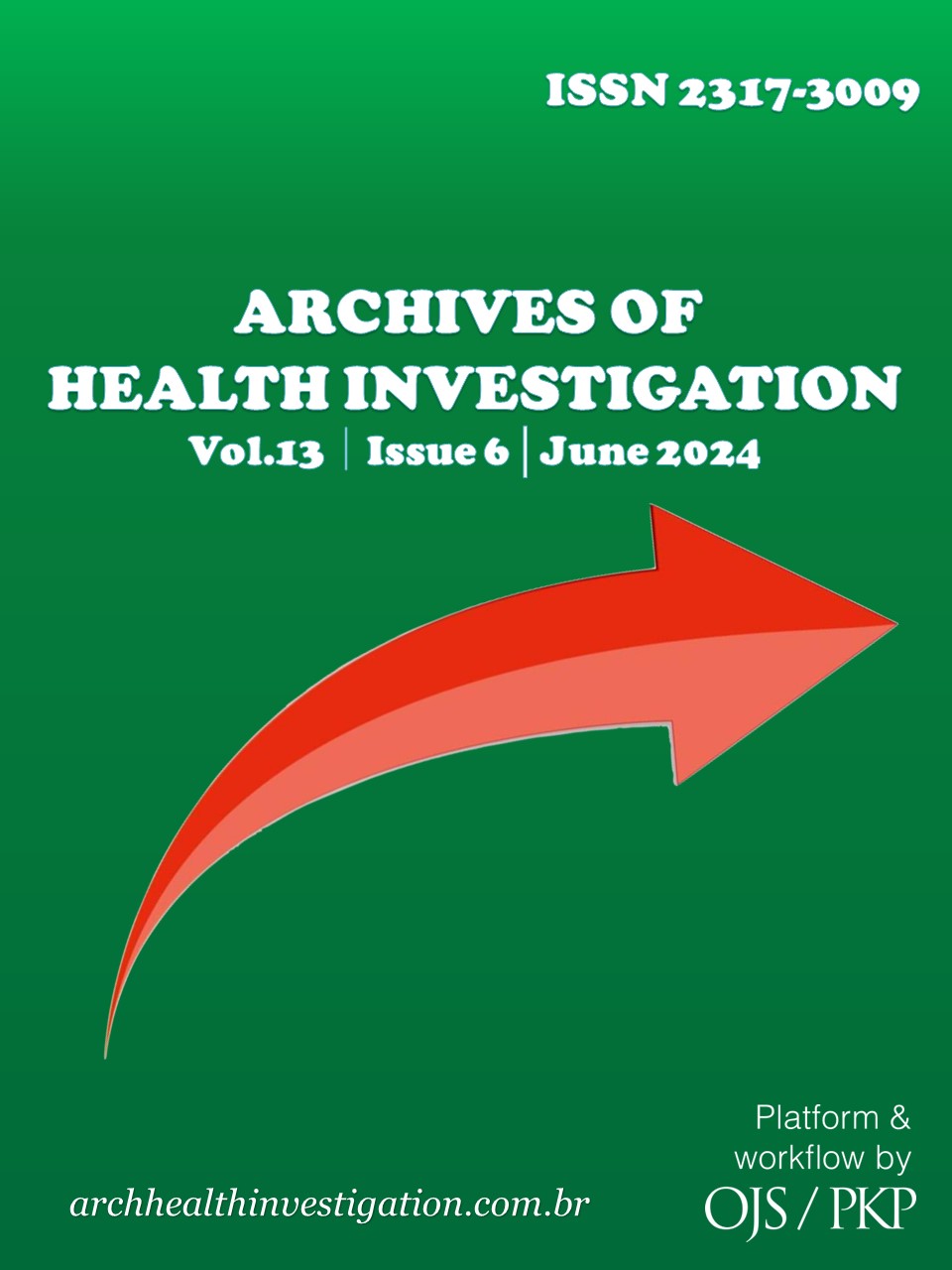Salivary Cortisol Levels and Periodontal Condition of Chemical Dependent Patients
DOI:
https://doi.org/10.21270/archi.v13i6.6382Palavras-chave:
Drug Users, Periodontal Diseases, Hydrocortisone, Public HealthResumo
Background: Drug addiction can harm oral health, as the use of illicit substances can reduce salivary flow and the buffering capacity of saliva, facilitating the development of periodontal disease. Salivary cortisol levels can influence oral health, as increased levels of this hormone may be related to a decreased immune response, affecting periodontal tissues. Objective: To evaluate salivary cortisol levels and their relationship with the periodontal condition of chemical dependent patients. Methods: The study was carried out on 60 institutionalized chemical dependent patients. Data on sociodemographic characteristics were collected through interviews and periodontal condition was assessed using the Community Periodontal Index. Analysis of salivary cortisol levels was performed using the ELISA method. Results: Of the 360 mouth sextants, 59 (16.39%) were healthy; 69 (19.17%) had bleeding on probing; 75 (20.83%) had dental calculus; 79 (21.94%) had periodontal pockets; and 78 (21.67%) were excluded. The average number of healthy sextants was 0.98+1.83; of sextants with bleeding on probing was 1.15+1.64; of sextants with dental calculus was 1.25+1.78; of sextants with periodontal pocket was 1.32+1.71; and of excluded sextants it was 1.28+1.91. The concentration of salivary cortisol was significantly higher (p=0.0015) in patients who had at least one sextant with gingival bleeding (89.31+96.06) compared to those who did not have gingival bleeding (23.96+29.09). Conclusion: The patients presented severe damage to their periodontal condition and those with gingival bleeding had a higher concentration of salivary cortisol.
Downloads
Referências
World Health Organization. Coronavirus Disease (COVID-19). Available at: https://www.paho.org/en/topics/coronavirus-infections/coronavirus-disease-covid-19-pandemic
Bouso JC, Révész D, Ona G, Rossi GN, Rocha JM, Dos Santos RG et al. Longitudinal and transcultural assessment of the relationship between hallucinogens, well-being, and post-traumatic growth during the COVID-19 pandemic. Sci Rep. 2023;13(1):14052.
Cadet JL. Epigenetics of Stress, Addiction, and Resilience: Therapeutic Implications. Mol Neurobiol. 2016;53(1):545-60.
El-Farhan N, Rees DA, Evans C. Measuring cortisol in serum, urine and saliva - are our assays good enough? Ann Clin Biochem. 2017;54(3):308-22.
Pulopulos MM, Baeken C, De Raedt R. Cortisol response to stress: The role of expectancy and anticipatory stress regulation. Horm Behav. 2020;117:104587.
Mariotti A. The effects of chronic stress on health: new insights into the molecular mechanisms of brain-body communication. Future Sci OA. 2015;1(3):FSO23
Zhang J, Lin S, Luo L, Zhang Q, Jiao Y, Liu W. Psychological stress: neuroimmune roles in periodontal disease. Odontology. 2023;111(3):554-64.
Cao R, Lai J, Fu X, Qiu P, Chen J, Liu W. Association between psychological stress, anxiety and oral health status among college students during the Omicron wave: a cross-sectional study. BMC Oral Health. 2023;23(1):470.
Yazdanian M, Armoon B, Noroozi A, Mohammadi R, Bayat AH, Ahounbar E et alDental caries and periodontal disease among people who use drugs: a systematic review and meta-analysis. BMC Oral Health. 2020;20(1):44.
Cossa F, Piastra A, Sarrion-Pérez MG, Bagán L. Oral manifestations in drug users: A review. J Clin Exp Dent. 2020;12(2):e193-e200.
Rossow I. Illicit drug use and oral health. Addiction. 2021;116(11):3235-3242.
Teoh L, Moses G, McCullough MJ. Oral manifestations of illicit drug use. Aust Dent J. 2019;64(3):213-22.
World Health Organization. Oral health surveys: basic methods, 5th ed. World Health Organization; 2013.
Ingram I, Kelly PJ, Deane FP, Baker AL, Goh MCW, Raftery DK, Dingle GA. Loneliness among people with substance use problems: A narrative systematic review. Drug Alcohol Rev. 2020;39(5):447-83.
Avci S, Sarikaya R, Kavak N, Özmen FN, Aydin M, Arslan ED, Büyükcam F. Socio-demographic and clinical profile of substance abuse patients admitted to an emergency department in Ankara, Turkey. Acta Biomed. 2016;87(3):286-90.
Kuteesa MO, Weiss HA, Cook S, Seeley J, Ssentongo JN, Kizindo R, Ngonzi P, Sewankambo M, Webb EL. Epidemiology of Alcohol Misuse and Illicit Drug Use Among Young People Aged 15-24 Years in Fishing Communities in Uganda. Int J Environ Res Public Health. 2020;17(7):2401.
Kuteesa MO, Weiss HA, Cook S, Seeley J, Ssentongo JN, Kizindo R, Ngonzi P, Sewankambo M, Webb EL. Epidemiology of Alcohol Misuse and Illicit Drug Use Among Young People Aged 15-24 Years in Fishing Communities in Uganda. Int J Environ Res Public Health. 2020;17(7):2401.
Basic A, Dahlén G. Microbial metabolites in the pathogenesis of periodontal diseases: a narrative review. Front Oral Health. 2023;4:1210200.
Akcalı A, Lang NP. Dental calculus: the calcified biofilm and its role in disease development. Periodontol 2000. 2018;76(1):109-15.
Donos N. The periodontal pocket. Periodontol 2000. 2018;76(1):7-15.
Ramseier CA, Anerud A, Dulac M, Lulic M, Cullinan MP, Seymour GJ et al. Natural history of periodontitis: Disease progression and tooth loss over 40 years. J Clin Periodontol. 2017;44(12):1182-191
Develioglu H, Korkmaz S, Dundar S, Schlagenhauf U. Investigation of the levels of different salivary stress markers in chronic periodontitis patients. J Oral Biol Craniofac Res. 2020;10(4):514-18.
Botelho J, Machado V, Mascarenhas P, Rua J, Alves R, Cavacas MA et al. Stress, salivary cortisol and periodontitis: A systematic review and meta-analysis of observational studies. Arch Oral Biol. 2018;96:58-65.
Marani F, Santos RM, Chiba FY, Tessarin GWL, Mattera MSLC, Tsosura TVS et al. Níveis Reduzidos de Melatonina Salivar em Indivíduos com Doença Periodontal: Revisão Sistematizada. Arch Health Invest. 2021;11(2)236-41.
Chiba FY, Sumida DH, Moimaz SAS, Chaves Neto AH, Nakamune ACMS, Garbin AJI et al. Periodontal condition, changes in salivary biochemical parameters, and oral health-related quality of life in patients with anorexia and bulimia nervosa. J Periodontol. 2019;90(12):1423-430.
Antoniazzi RP, Zanatta FB, Rösing CK, Feldens CA. Association Among Periodontitis and the Use of Crack Cocaine and Other Illicit Drugs. J Periodontol. 2016;87(12):1396-405.
Bahdila D, Aldosari M, Abdullah A, Nelson JL, Hegazi F, Badamia R et al. Cocaine, polysubstance abuse, and oral health outcomes, NHANES 2009 to 2014. J Periodontol. 2020;91(8):1039-48.


